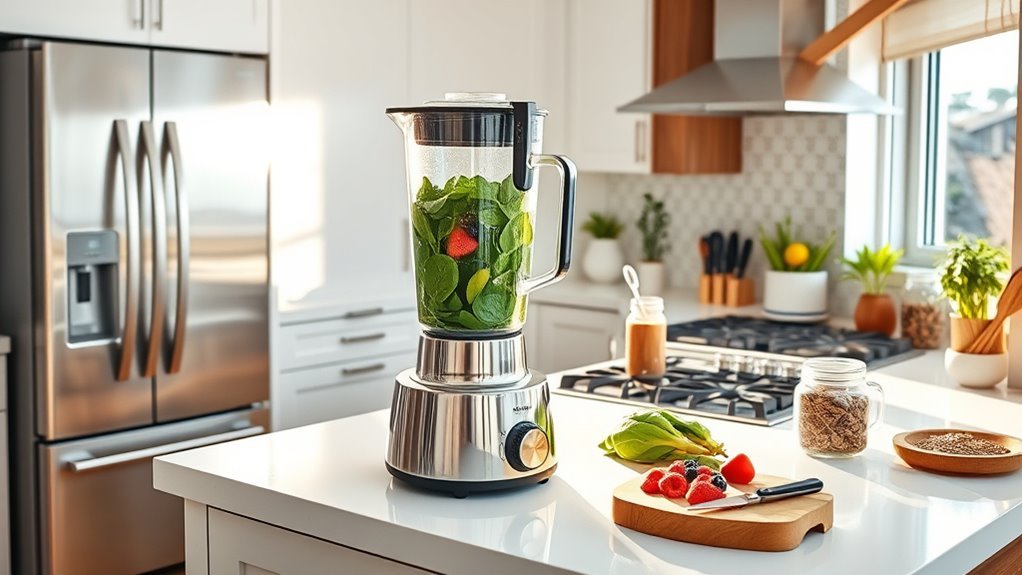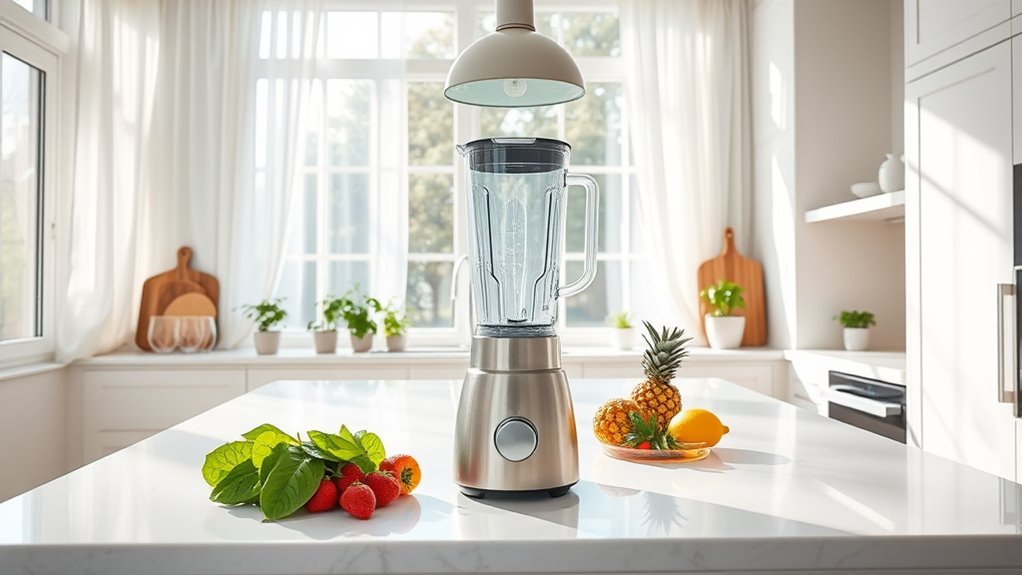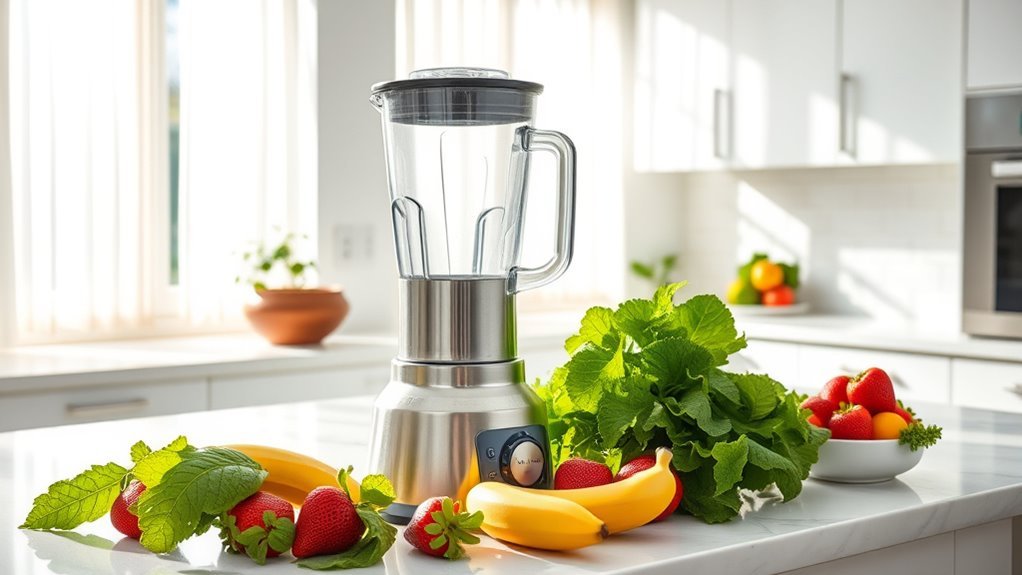For the safest smoothie blending, we’ve ranked the top materials: borosilicate glass leads the pack for its thermal resistance and zero chemical leaching, followed by food-grade stainless steel for durability. Next come Eastman Tritan copolyester and BPS-free polypropylene containers – but watch for certification. Quality tempered glass, Pyrex, and high-grade polycarbonate round out the list, though plastic options require careful temperature monitoring. Let’s explore what makes these materials your healthiest choices.
Understanding Glass Vs Plastic Safety in Blender Jars

When it comes to blender jar safety, the choice between glass and plastic isn’t just about durability – it’s about your health.
We’re seeing more evidence that plastic blender jars can leach harmful chemicals like BPA into our smoothies, especially when we’re blending hot or acidic ingredients. Even “BPA-free” alternatives often use similarly questionable substitutes.
That’s why we’re big fans of borosilicate glass blender jars. They’re non-reactive, meaning no unwanted chemicals in your drinks, and they handle temperature changes like champs. Additionally, using a high-performance blender can enhance the blending process, ensuring smoother textures and better nutrient retention in your smoothies.
While they’re heavier and require careful handling, glass jars are worth the extra attention. They’re easier to clean, won’t retain odors, and won’t stain like plastic does.
Plus, you’ll never have to wonder what’s secretly seeping into your morning smoothie.
Key Properties of Borosilicate Glass Containers
Since borosilicate glass stands leagues above regular glass in thermal resistance, it’s our go-to material for serious smoothie blending. We’re talking unmatched thermal shock resistance that laughs at both scorching and freezing temperatures.
Let’s break down why borosilicate glass jars dominate: they’re non-reactive, so your healthy smoothies stay pure without chemical leaching.
Their enhanced strength and high durability mean you’ll get years of faithful service. What’s more, they’re dishwasher safe and maintain clear hygiene – no lingering smells or stains.
Those handy measurement marks guarantee consistency in your recipes every time. Additionally, high-performance blenders often come equipped with larger jar capacities, making them ideal for blending larger quantities of your favorite smoothies.
Trust us, when it comes to precision blending, nothing beats borosilicate’s combination of safety, durability, and practicality. It’s simply the smartest choice for your smoothie game.
Benefits of Food-Grade Stainless Steel Jars

Food-grade stainless steel delivers heavyweight durability with zero compromises on safety.
We’re talking about a non-reactive material that won’t leach chemicals into your smoothies, no matter how acidic your ingredients get. It’s completely BPA-free – no hormone-disrupting nasties here.
Let’s get practical: these jars are virtually indestructible, laughing off dents and scratches while handling both frozen berries and hot soups.
They’re ridiculously easy to clean, and you won’t find lingering smells or stubborn stains. Pop them in the dishwasher – done.
Best part? We’re making an environmentally friendly choice.
These recyclable containers are a sustainable alternative to disposable plastic jars. Trust us, if you’re serious about hygienic blending experiences, food-grade stainless steel is your bulletproof solution.
Common Risks With Low-Quality Plastic Materials
Low-quality plastic blender jars pose serious health risks we can’t ignore. When exposed to high temperatures during blending, these materials can leach harmful chemicals like BPA and phthalates into your smoothies. Let’s examine why we’re ditching cheap plastic for safer alternatives.
| Material Risk | Temperature Impact | Health Concern |
|---|---|---|
| BPA Exposure | Leaches at 70°C+ | Endocrine Disruption |
| Phthalates | Releases in Heat | Reproductive Issues |
| Worn Plastic | Degrades Over Time | Increased Toxicity |
| Acidic Contact | Accelerates Leaching | Chemical Exposure |
| Micro-plastics | Breaks Down in Use | Digestive Problems |
We’re seeing more consumers switch to glass or stainless steel jars – and for good reason. These safe parts eliminate toxic material concerns and deliver peace of mind. Your health isn’t worth risking on low-quality plastics when better options exist.
Impact of Heat and Acidity on Jar Materials

When blending hot ingredients or acidic fruits, your choice of jar material becomes critically important for both safety and durability.
Let’s be clear: plastic components don’t play nice with heat or acidic foods. They’ll leach harmful chemicals like BPA right into your smoothie – and we’re not about that.
For health-conscious blending, we’re looking at two superior alternatives. First, non-reactive glass jars, especially borosilicate ones, won’t contaminate your drinks no matter how hot or acidic things get.
Second, high-grade stainless steel proves equally reliable. Both materials laugh in the face of heat and acidity while keeping your beverages chemical-free.
Don’t risk your health with cheap plastic that’ll break down over time. Invest in glass or stainless steel – your body will thank you.
Evaluating BPA-Free and Tritan Alternatives
Although manufacturers tout “BPA-free” plastics as the solution to our chemical concerns, we’re not buying the hype.
Here’s why: alternatives like BPS and BPF carry similar health risks, and even Tritan plastic raises red flags about potential estrogenic effects.
Let’s cut through the marketing noise.
All plastic blender jars can leach chemicals into your smoothies, especially when heat or acidic ingredients enter the equation.
Those reassuring “BPA-free” labels? They’re not telling the whole story.
We’re seeing clear winners emerge in the safety department: borosilicate glass and high-quality stainless steel blender jars.
They’re non-reactive and won’t dump unwanted chemicals into your morning shake.
Want real safety? Look beyond fancy plastic labels.
Demand transparent safety certifications and materials that actually minimize health risks.
Essential Safety Certifications for Blender Materials
Since manufacturers can slap any claims they want on blender packaging, you’ll need to get savvy about safety certifications. Let’s cut through the marketing fluff and focus on what really matters for your health.
| Certification | What It Means | Why It Matters |
|---|---|---|
| NSF International | Independent testing for food safety | Verifies blender jar materials meet strict standards |
| UL Compliance | Safety testing for electrical products | Guarantees both electrical and material safety |
| FDA FCS Approval | Food contact safety verification | Confirms food-grade materials in plastic components |
We’ll be blunt: avoid anything with a California Proposition 65 warning. Watch for BPA substitutes like BPS and BPF – they’re just as problematic. Instead, look for third-party testing certifications that actually mean something. Your smoothie shouldn’t come with a side of harmful chemicals.
Frequently Asked Questions
What Type of Blender Is Best for Making Smoothies?
We recommend high-powered blenders (700+ watts) for perfect smoothie consistency and frozen fruits. They’ll give you ideal blending techniques, letting you experiment with ingredient combinations while preserving nutrients in every portion.
Are BPA Free Blenders Safe?
While BPA-free blenders sound safer, we should be cautious as they may contain harmful alternatives like BPS and BPF. We’d recommend choosing glass or stainless steel options for truly health-conscious smoothie making.
What Is the Best Glass Blender Without Plastic?
With 90% of consumers prioritizing health, we’d recommend the Ninja Foodi glass blender for its borosilicate construction, heating element, and eco-friendly design that eliminates plastic contamination concerns while ensuring durability.
What Is the Best Appliance to Make a Smoothie?
We recommend a high-powered blender like Vitamix or Blendtec for perfect smoothie recipes. They offer essential blender features to handle frozen fruits and create smooth ingredient combinations for nutritious meal replacements.

